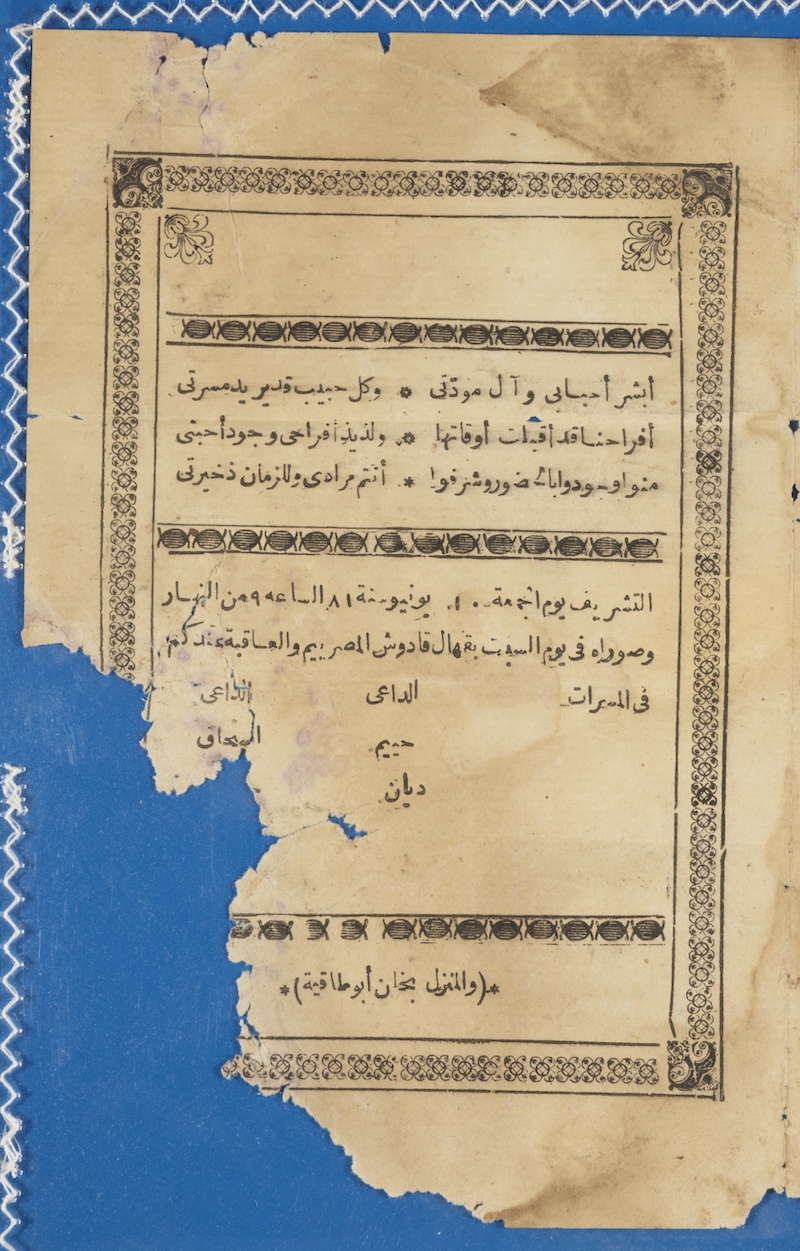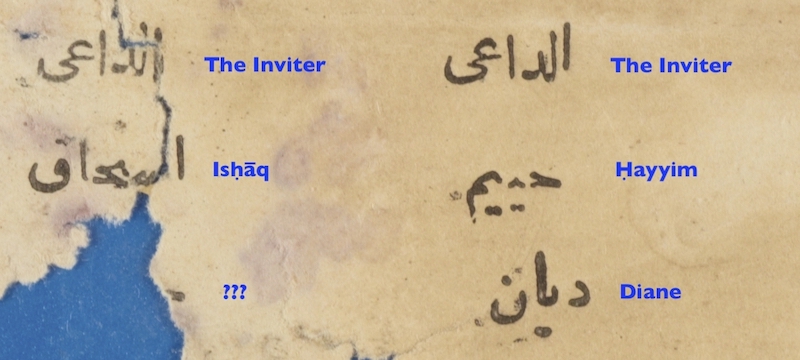A Fustat Summer Wedding: Pictures and Poetry in T-S NS 266.113
The Cairo Genizah is well-known as a repository for ancient Bibles, grand theological treatises, and the personal papers of some of medieval Judaism’s greatest thinkers. More mundane, but no less interesting, are the countless documents that reflect similarities between our modern lives and those of people who lived centuries ago. These items reveal everyday happenings that we are still familiar with, from homework, cookbooks, and calendars, to receipts, tax forms, and letters warning loved ones about plagues.[1] They also show one activity that is absolutely inescapable, regardless of differences in time or place: wedding planning.
T-S NS 266.113 is a paper bifolium, full of holes and thoroughly stained with water (and perhaps a bit of wine), that measures 21.1 x 27.3 cm. The recto of the first leaf is a wedding invitation printed with Arabic moveable type. It is in decent shape – legible, at any rate, and with a stylish border – but the lower left corner is torn off, so a small amount of text is lost. The verso of the first leaf and the entire second leaf are blank, suggesting that this invitation was a spare that no guest ever received.

Fig. 1: T-S NS 266.113, f. 1r.
The entire text is in Arabic script, with no Hebrew letters anywhere, so we may wonder why it is in the Genizah at all. Wedding invitations are not common in the collections, and I know of only one other. The three fragments known as Manchester A 1053, Manchester B 2699, and Manchester B 2977 are from three copies of another invitation, printed in French, to the wedding of Mr. Moise Mosseri (c. 1855-1933) and Miss Henriette Nahmias (1868-1943). The Mosseris were a famous Cairene banking family,[2] which may give a sense of who could afford to have invitations professionally printed in the late nineteenth century. French documents are also rare in the Genizah,[3] but someone – a young Mosseri being the likely culprit – has re-used the back of these invitations to practice the Hebrew alphabet.
It seems that another kind of recycling happened with T-S NS 266.113. There are symmetrical folds along the top of the bifolium that are consistent with paper used to create the hardcover binding of books. Recycling discarded texts for this purpose was common among Middle Eastern bookbinders from the medieval period onwards,[4] which may explain why some fragments ended up in genizot even without traces of Hebrew.
The invitation begins with a poem:
أبشر أحبابي وآل مودّتي ❊ وكل حبيب قدير يد مسرتي
أفراحنا قد أقبلت أوقاتها ❊ ولذيذ أفراحي وجود أحبتي
منو اوجودوا بالحضور وشرفوا ❊ أنتم مرادي وللزمان ذخيرتي
Rejoice, my beloved friends and family, and every dear friend who may bring me joy!
The time of our wedding festivities has drawn near, and the sweetness of my celebration is the presence of my beloveds;
a wish that they be present and honoured in attendance. You are all my desire, and forever my treasure.
Visually, the text is arranged to look like a Classical Arabic poem, but the language is a little rough around the edges. Its perspective is that of the bride or groom, and perhaps one of them composed it. Their names do appear below, in two columns each with the heading al-dāʿī (“the inviter”). The first has the names Ḥayyim and Diane, while the second has Isḥāq and a tear where the next name should be. The headings suggest that each column is a single person, apparently with surnames listed first, so the two betrothed are Diane Ḥayyim and [. . .] Isḥāq.

Fig. 2: Names of the hosts.
The essential information for invitees follows the poem:
“The ceremony is Friday, June 10th, 1881 at 3 p.m., and a picture on Saturday in the holy community of the Egyptians, ending with you all in delight.”
Opting for a summer wedding (always in style), the ceremony was scheduled on a Friday afternoon, ensuring that it ended in time for Shabbat. A note at the bottom of the page gives the location: “The house at Khān Abū Ṭāqiyya,” a street in Cairo’s al-Gamaliya district, named after the caravansary of the seventeenth-century merchant Ismaʿīl Abū Ṭāqiyya.[5] It is about 7 km from the Ben ʿEzra Synagogue, but only a few hundred meters from Rabbi Moshe Synagogue, the site where Maimonides is said to have first been laid to rest.
The 1881 date places this wedding near the end of the Genizah period, less than 16 years before Schechter would arrive in Fustat. It is not clear that the Cairene Jewish community still actively stored documents in the Ben Ezra Genizah chamber during this time. Instead, it may be more likely that T-S NS 266.113 comes from a genizah at al-Basātīn cemetery, where Egyptian Jews continued to bury documents even into the twentieth century, and from which Schechter also acquired a substantial number of fragments that are now in the Taylor-Schechter collections.[6]
The word I have translated as “picture” (صوراه) in the message looks a bit strange. Although it is in Arabic characters, it is spelled more like a Hebrew word (e.g. צוּרָה) than standard Arabic (صورة), and it may have a different meaning in the context of a nineteenth-century Jewish wedding. At any rate, it cannot have been easy to arrange for a wedding photographer in pre-modern Cairo. Photography was not unknown in Egypt in 1881, but it was still an emerging technology,[7] and sitting for a photograph (on Shabbat, no less) would have been a novel experience. Another possibility is that this word is a transcription of the French soirée, referring to an evening party on Saturday night.
The way that the couple refers to their community here is also interesting. They call it qahāl qādūsh (قهال قادوش), “holy community” of the Egyptians. This moniker is not Arabic, but rather the Hebrew phrase קהל קדוש written in Arabic characters, leaving little doubt that Diane and her fiancé were Jewish.

Fig. 3: “The holy community of the Egyptians,” with Hebrew transcribed in Arabic characters.
We see that the happy couple faced a decision which most English-speakers would never consider: which alphabet should you use for your wedding invitation? Even for an Arabic message, the logical choice for most Cairene Jews was Hebrew script, continuing a long tradition of Judaeo-Arabic writing in the Middle East and North Africa. On the other hand, printing in Judaeo-Arabic would have meant that only Jews could read the invitation, a feature which may or may not have been desirable. Moreover, while past centuries had seen a few attempts at establishing Hebrew printing in Cairo, in 1881 there was only one modern Egyptian printing press that handled Hebrew type, and it was all the way in Alexandria.[8] So perhaps the decision was really more one of convenience: affordable local Arabic versus expensive mail-order Hebrew (or worse yet, copying invitations by hand).
T-S NS 266.113 is not a fragment of an ancient Torah scroll. It does not shed light on the medieval community of Abraham Maimonides, nor does it uncover new poetry from the likes of Judah Halevi. It is not even really a useful source for evaluating the state of the Genizah just before Schechter’s arrival. All it offers is a momentary glimpse into the experience of two young Cairenes starting a life together on the eve of British occupation, and reminds us that their experience was not so different from our own. We do not know what happened after their wedding, but they would have marked their 139th anniversary just a few weeks ago.
Bibliography
Daniel, Malcolm. “Photographers in Egypt.” In Heilbrunn Timeline of Art History. New York: The Metropolitan Museum of Art, 2004. https://www.metmuseum.org/toah/hd/treg/hd_treg.htm.
Déroche, François et al. Islamic Codicology: An Introduction to the Study of Manuscripts in Arabic Script. Edited by Muhammad Isa Waley. Translated by Deke Dusinberre and David Radzinowicz. 2nd edition. London: Al-Furqān Islamic Heritage Foundation, 2015.
Guerin, Adam. “Mosseri Family.” In Encyclopedia of Jews in the Islamic World, edited by Norman A. Stillman. Brill, 2010. https://referenceworks.brillonline.com/entries/encyclopedia-of-jews-in-t....
Hanna, Nelly. Making Big Money in 1600: The Life and Times of Isma’il Abu Taqiyya, Egyptian Merchant. Middle East Studies Beyond Dominant Paradigms. Syracuse: Syracuse University Press, 1998.
Hoffman, Adina, and Peter Cole. Sacred Trash: The Lost and Found World of the Cairo Geniza. New York: Nextbook, Schocken, 2011.
Jefferson, Rebecca J.W. “Deconstructing ‘the Cairo Genizah’: A Fresh Look at Genizah Manuscript Discoveries in Cairo before 1897.” Jewish Quarterly Review 108, no. 4 (2018): 422–48.
Rowland-Smith, Diana. “The Beginnings of Hebrew Printing in Egypt.” British Library Journal, 1989, 16–22.
Footnotes
[1] See, for example: T-S 8J22.6; T-S 8J40.8; T-S 13J27.15; T-S 18J2.11; T-S NS 321.93; and Mosseri Ia, 10.2.
[2] Adam Guerin, “Mosseri Family,” in Encyclopedia of Jews in the Islamic World, ed. Norman A. Stillman (Brill, 2010), https://referenceworks.brillonline.com/entries/encyclopedia-of-jews-in-t....
[3] Rare, but not entirely absent, especially in later fragments. The Egyptian elite spoke French as a prestige language during the nineteenth century.
[4] François Déroche et al., Islamic Codicology: An Introduction to the Study of Manuscripts in Arabic Script, ed. Muhammad Isa Waley, trans. Deke Dusinberre and David Radzinowicz, 2nd edition (London: Al-Furqān Islamic Heritage Foundation, 2015), 264.
[5] Nelly Hanna, Making Big Money in 1600: The Life and Times of Isma’il Abu Taqiyya, Egyptian Merchant, Middle East Studies Beyond Dominant Paradigms (Syracuse: Syracuse University Press, 1998), 121.
[6] See Rebecca J.W. Jefferson, “Deconstructing ‘the Cairo Genizah’: A Fresh Look at Genizah Manuscript Discoveries in Cairo before 1897,” Jewish Quarterly Review 108, no. 4 (2018): 428–9, 441–2.
[7] Malcolm Daniel, “Photographers in Egypt,” in Heilbrunn Timeline of Art History (New York: The Metropolitan Museum of Art, 2004), https://www.metmuseum.org/toah/hd/treg/hd_treg.htm. Somewhat infamously, there are no pictures of the interior of the Genizah chamber before Schechter emptied it. Agnes Lewis and Margaret Gibson had intended to take photographs with their (at the time) state-of-the-art portable camera when they visited Schechter in Cairo in 1897, but they left it in their hotel room by mistake; Adina Hoffman and Peter Cole, Sacred Trash: The Lost and Found World of the Cairo Geniza (New York: Nextbook, Schocken, 2011), 77.
[8] Diana Rowland-Smith, “The Beginnings of Hebrew Printing in Egypt,” British Library Journal, 1989, 21.
Cite this article
Posegay, N. (2020). A Fustat Summer Wedding: Pictures and Poetry in T-S NS 266.113. [Genizah Research Unit, Fragment of the Month, June 2020]. https://doi.org/10.17863/CAM.65550
If you enjoyed this Fragment of the Month, you can find others here.
Contact us: genizah@lib.cam.ac.uk
To see other manuscripts from the Cairo Genizah visit Cambridge Digital Library at: https://cudl.lib.cam.ac.uk/
